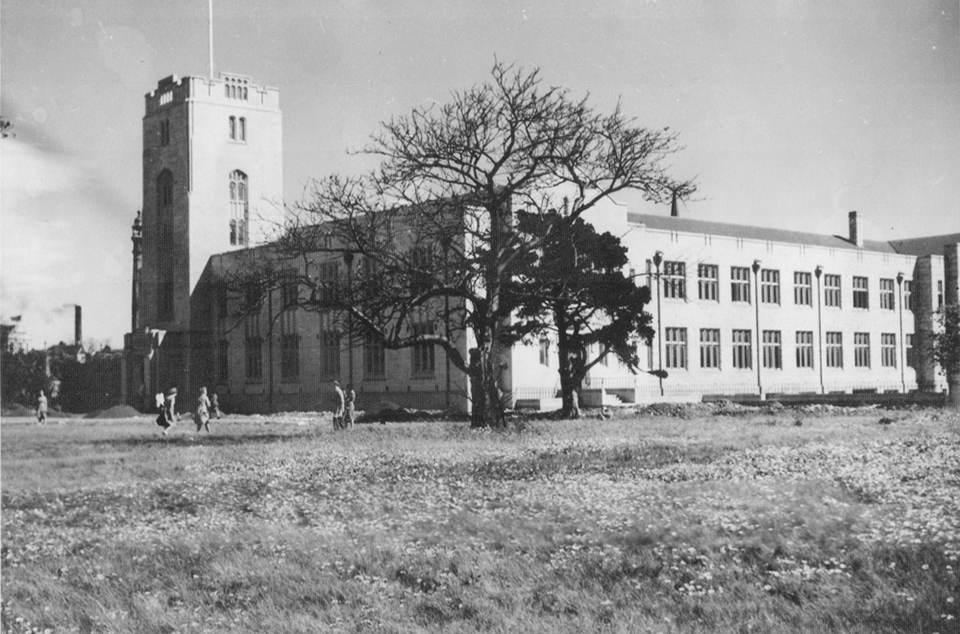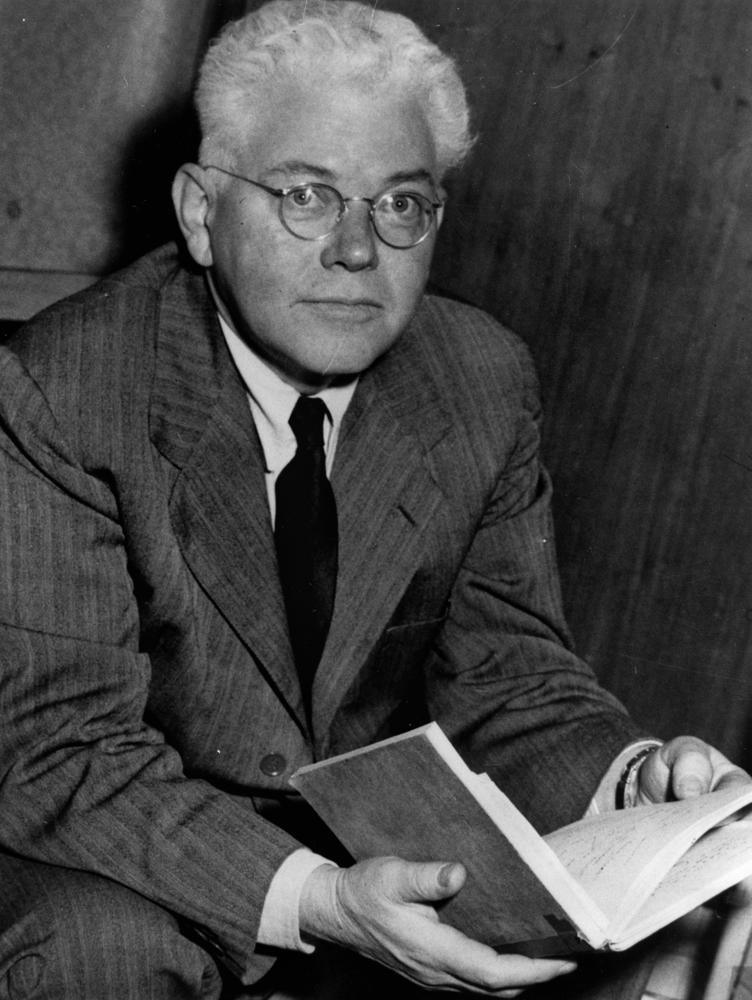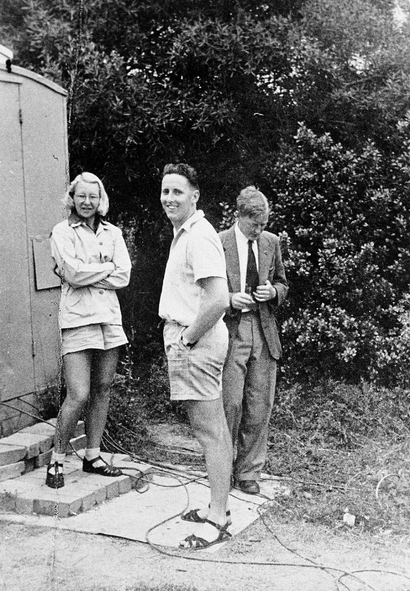The Dictionary of Sydney was archived in 2021.
Radar
Citation
Persistent URL for this entry
To cite this entry in text
To cite this entry in a Wikipedia footnote citation
To cite this entry as a Wikipedia External link
Radar
In the early months of World War II, Sydney's scientific community rallied to the Allied cause, quickly realising the importance of physicists, meteorologists, chemists and engineers to the war effort. Some areas of research suddenly became vital to the war effort, and radar was one of those. The Council for Scientific and Industrial Research, CSIR, quickly set up a Radiophysics Division, housed at the University of Sydney.
CSIR (later CSIRO) Radiophysics Division [media]occupied the rear half of the National Standards Laboratory building constructed at Sydney University for CSIR in early 1940. This building is now known as the Madsen building in memory of Professor JPV Madsen, Professor of Electrical Engineering in the university and Chairman of the Radiophysics Advisory Board and the Radio Research Board. The experienced engineers and scientists recruited for Radiophysics Division came from the Radio Research Board and from industry; the Radio Research Board proved to be an invaluable precursor and training ground for Radiophysics. [1]
Secret information on the technique of using radio waves to detect aircraft and ships, later known as radar, was brought to Australia from the United Kingdom in 1939 by Dr DF Martyn. [2] The Division used the equipment supplied and associated engineering information to design and build radar systems for use by the Australian Army, Navy and Air Force during World War II. [3] While the first radar model was a derivative of a British design, later models were significant new designs using local components and/or redesigns to meet Australian requirements, which were different from those in the European theatre of war.
The phenomenon of radar was already known in Australia at that time. Radio Research Board scientists working in Sydney in the 1930s had perfected a form of radar, called an ionosonde, for probing the height (and other properties) of the ionospheric reflective layers. Thus, Radio Research Board scientists were well prepared for the passing on of British radar information and for the subsequent design and development of radar equipment.
Radar at Dover Heights
The [media]first Australian-built radar was the Shore Defence (ShD) radar, tested at Dover Heights in Sydney in 1940, and this was designed to detect enemy shipping. [4] An innovative feature of the Australian design was the use of one antenna on one tower for both sending and receiving the radio pulses and this was later copied in the United Kingdom. [5] Due to the approaching air threat, the ShD radar was used as the basis for the design of an air-warning (AW) radar. An AW prototype was designed and built in five and a half days – this is indicative of the hothouse environment in the Radiophysics Division for much of the war. This prototype had no safety covers, leaving the crew exposed to dangerous voltages. Due to the [media]urgency of the war situation, it was put into immediate operational use at Dover Heights in December 1941, and was the sole means of electronic air surveillance for some months. [6] Of the first production run, one AW radar was sent to Darwin.
The first Japanese air raid on Darwin created widespread devastation of the township, with heavy loss of life, and damaged telecommunications equipment and shipping in the port. The AW radar was barely out of its crate and was not operational despite the best efforts of the Royal Australian Air Force crew. [7] Scientists from Radiophysics in Sydney were sent to Darwin to get it working, in time to warn of the second air raid which was effectively repelled. AW radar was also used successfully at Townsville to detect and direct the shooting down of a Japanese bomber.
Australian innovation
An [media]excellent example of innovative Australian design was the Light Weight Air Warning radar (LW/AW) designed by a team led by Dr JH Piddington and BF Cooper. [8] The LW/AW was developed in September 1942 for the Royal Australian Air Force as an air-transportable radar which was easily disassembled and reassembled in the field by the radar team. [9] LW/AW was significantly lighter at 2–3 tons than American models which weighed as much as 40 tons; LW/AW could be set up in a matter of four hours: it was simple, rugged and tropic-proof in construction. [10] If the LW/AW radar was ever turned off for maintenance, electric heaters were turned on to keep the equipment hot to prevent mould growth and corrosion.
LW/AW was much in demand from the United States forces during the Pacific war. [11] The technical characteristics of the LW/AW radar are similar to current radars used by the Royal Australian Air Force in terms of size, weight and other specifications. [12] Professor V Bailey and his staff in the Physics School of the University of Sydney provided thorough scientific training for radar officers, who were to command the radar squadrons. [13] Technicians were trained in the Royal Australian Air Force to undertake all repairs in the field, to a higher level than American technicians.
[media]Stories of the operational uses of Australian radars provide some insight into the difficulties of working in the tropics. [14] The only remaining LW/AW radar is held by the Australian War Memorial in Canberra and was on display in 2010, along with a Rebecca unit (a radio beacon which was the basis of postwar developments with Distance Measuring Equipment) designed by Radiophysics staff. About the same time as LW/AW was being developed, Dr Pulley in the Radiophysics Division designed a Doppler radar (which measures the radial speed of the target using the Doppler effect), but this truly original idea did not go into production due to lack of resources and the need to concentrate effort on the LW/AW radar. [15] Another significant innovation was the development of the Air-warning Height-measuring (AWH) radar. In addition to providing the usual range and bearing information, the AWH radar provided also the height of the target. [16]
Microwave radar
A [media]major innovative change in radar was the use of microwave radiation instead of ultra high frequency UHF. The lack of an efficient microwave generator was dealt with by the invention of the resonant cavity magnetron by a research group at Birmingham University, led by an Australian, Professor Mark Oliphant, in 1940. Magnetrons were crucial in the Battle of Britain as they improved the ability of radar to detect low-flying aircraft. In the naval setting, microwave radar enhanced the ability to detect small targets such as submarines, so Radiophysics developed a microwave radar for the Royal Australian Navy by October 1941. Since magnetrons were not available, the University of Melbourne valve laboratory of the Radio Research Board set to work to construct a prototype magnetron using information provided from England; the prototype was then redesigned to generate 25 centimetre radiation. [17] At this point, the prototype was taken to Amalgamated Wireless Australasia (AWA) and Standard Telephones & Cables (STC), for development into a production model, which was made in quantity for the naval microwave radar (A271L) in production at AWA. [18] The details of the manufacture of the magnetron have not been discussed here, however the fabrication of these high technology valves was not trivial and required the development of many new techniques by industry, such as glass–metal seals.
A short article cannot do justice to the variety and quality of the work undertaken by Radiophysics – overall, the Division designed more than 20 radar models with a total production of 2,076 radar systems and 9,085 items of radar test equipment. [19] The workshops in Radiophysics Division built the prototype radars to the design of the engineers and scientists. After successful testing in the laboratory and at Dover Heights, these prototypes were passed to PMG Research Laboratory where engineers designed and produced the production model, which was passed to the industrial partners such as AWA and Gramophon (EMI) for quantity production [20] under the supervision of the Department of Munitions and of Defence. [21] Each of these steps towards the final production item required engineering skill and ingenuity.
Scientific excellence
Many wartime [media]scientific and engineering staff rose to eminence, notably Dr DF Martyn, Dr JL Pawsey, HC Minnett, Dr JH Piddington, JN Briton, Professor FWG White, and two illustrious women Ruby Payne-Scott and Professor Joan Freeman, in addition to Professor JPV Madsen, Chairman of the Radiophysics Advisory Board. [22] Wartime administrative staff who rose to eminence included Marjorie Barnard, writer and author of an unpublished history of the Radiophysics Division, and a young Joan Sutherland. Even the office boy, AG Little, became an Associate Professor of Physics at the University of Sydney. [23]
In [media]the postwar period, Dr EG Bowen was Chief of CSIRO Radiophysics Division and the skills amassed during wartime were redirected in many areas, including technologies associated with radio beacons, the electronic computer (the first Australian computer, CSIRAC, was built there in 1949), semiconductors and the instrument landing system Interscan, which was developed by Dr JP Wild and was adopted subsequently as an international standard in aviation. CSIRO Radiophysics undertook fundamental research in radioastronomy, in which Australia quickly became a world leader.
References
WF Evans, History of the Radiophysics Advisory Board 1939–1945, Commonwealth Scientific and Industrial Research Organisation, Melbourne, 1976
A McKay, Surprise and enterprise, Commonwealth Scientific and Industrial Research Organisation, Melbourne, 1976
DP Mellor, The Role of Science and Industry, vol 5, Australia in the War of 1939–45 Series Four, Australian War Memorial, Canberra, 1958, chapter 19
Notes
[1] CB Schedvin, Shaping science and industry: a history of Australia's Council for Scientific and Industrial Research, 1926–49, Allen & Unwin, Sydney, 1987; M Keentok, 'Synergy and symbiosis between university and industry: Radio research in the University of Sydney, the Radio Research Board and AWA', seminar, University of Sydney Sesquicentenary/Australian Science History Club, University of Sydney, 26 October 2002
[2] DP Mellor, The Role of Science and Industry, vol 5, Australia in the War of 1939–45 Series Four, Australian War Memorial, Canberra, 1958, chapter 19; CB Schedvin, Shaping science and industry: a history of Australia's Council for Scientific and Industrial Research, 1926–49, Allen & Unwin, Sydney, 1987
[3] DP Mellor, The Role of Science and Industry, vol 5, Australia in the War of 1939–45 Series Four, Australian War Memorial, Canberra, 1958, chapter 19
[4] DP Mellor, The Role of Science and Industry, vol 5, Australia in the War of 1939–45 Series Four, Australian War Memorial, Canberra, 1958, chapter 19
[5] DP Mellor, The Role of Science and Industry, vol 5, Australia in the War of 1939–45 Series Four, Australian War Memorial, Canberra, 1958, p 431
[6] DP Mellor, The Role of Science and Industry, vol 5, Australia in the War of 1939–45 Series Four, Australian War Memorial, Canberra, 1958, p 434 gives further details of the design of the AW radar.
[7] DP Mellor, The Role of Science and Industry, vol 5, Australia in the War of 1939–45 Series Four, Australian War Memorial, Canberra, 1958, p 435; CB Schedvin, Shaping science and industry: a history of Australia's Council for Scientific and Industrial Research, 1926–49, Allen & Unwin, Sydney, 1987
[8] DP Mellor, The Role of Science and Industry, vol 5, Australia in the War of 1939–45 Series Four, Australian War Memorial, Canberra, 1958, chapter 19; A McKay, Surprise and enterprise, Commonwealth Scientific and Industrial Research Organisation, Melbourne, 1976
[9] DP Mellor, The Role of Science and Industry, vol 5, Australia in the War of 1939–45 Series Four, Australian War Memorial, Canberra, 1958, chapter 19; R Macleod, 'The Boffins of Botany Bay: radar at the University of Sydney 1939–1945', Historical Records of Australian Science, vol 12, no 4, 1999, pp 411–93; Radar Returns, vol 2 no 3, June 1997, p 4; vol 4 no 2, July 1999, p 4
[10] DP Mellor, The Role of Science and Industry, vol 5, Australia in the War of 1939–45 Series Four, Australian War Memorial, Canberra, 1958; Australian Munitions Digest, 1944, pp 163–64
[11] General Macarthur requested 30 LW/AW radars for use by US forces in the Pacific war. A total of 60 LW/AWs were supplied to the US forces in the South West Pacific. E Simmonds and N Smith (eds), Radar Yarns, Radar Returns, Hampton Victoria., 2007, p 21, available at http://www.radarreturns.net.au/archive/Radar%20YarnsRRWS.pdf, viewed 2 March 2011
[12] Radar Returns, vol 1, no 4, September 1996, p 5
[13] R Macleod, 'The Boffins of Botany Bay: radar at the University of Sydney 1939–1945', Historical Records of Australian Science, vol 12, no 4, 1999, pp 411–93
[14] N Smith and F Coghlan, Secret Action of 305 The story of RAFF Radar Station 305, RAAF Museum, Point Cook Victoria, 1989; E Simmonds and N Smith (eds), Radar Yarns, Radar Returns, Hampton Victoria., 2007, available at http://www.radarreturns.net.au/archive/Radar%20YarnsRRWS.pdf, viewed 2 March 2011
[15] DP Mellor, The Role of Science and Industry, vol 5, Australia in the War of 1939–45 Series Four, Australian War Memorial, Canberra, 1958, chapter 19 pp 448–49
[16] A McKay, Surprise and enterprise, Commonwealth Scientific and Industrial Research Organisation, Melbourne, 1976 p 22
[17] DP Mellor, The Role of Science and Industry, vol 5, Australia in the War of 1939–45 Series Four, Australian War Memorial, Canberra, 1958, chapter 19 p 447
[18] DP Mellor, The Role of Science and Industry, vol 5, Australia in the War of 1939–45 Series Four, Australian War Memorial, Canberra, 1958, chapter 19 pp 446–48
[19] Mellor states there were 20 models but Evans indicates there were more radar projects than this – however some of these did not go into quantity production. DP Mellor, The Role of Science and Industry, vol 5, Australia in the War of 1939–45 Series Four, Australian War Memorial, Canberra, 1958, chapter 19, p 450; WF Evans, History of the Radiophysics Advisory Board 1939–1945, Commonwealth Scientific and Industrial Research Organisation, Melbourne, 1976; Australian Munitions Digest 1945
[20] WF Evans, History of the Radiophysics Advisory Board 1939–1945, Commonwealth Scientific and Industrial Research Organisation, Melbourne, 1976; Australian Munitions Digest, 1944, pp 158–59, 161
[21] The Radar School Rushcutters Bay inspected and supervised industrial production of radar systems. GR Worledge, Contact! HMAS Rushcutter and Australia's submarine hunters 1939–1946, Anti-submarine Officers' Association, Sydney, 1994
[22] R Home, Physics in Australia to 1945, University of Melbourne, Melbourne, 1990
[23] WF Evans, History of the Radiophysics Advisory Board 1939–1945, Commonwealth Scientific and Industrial Research Organisation, Melbourne, 1976
.









